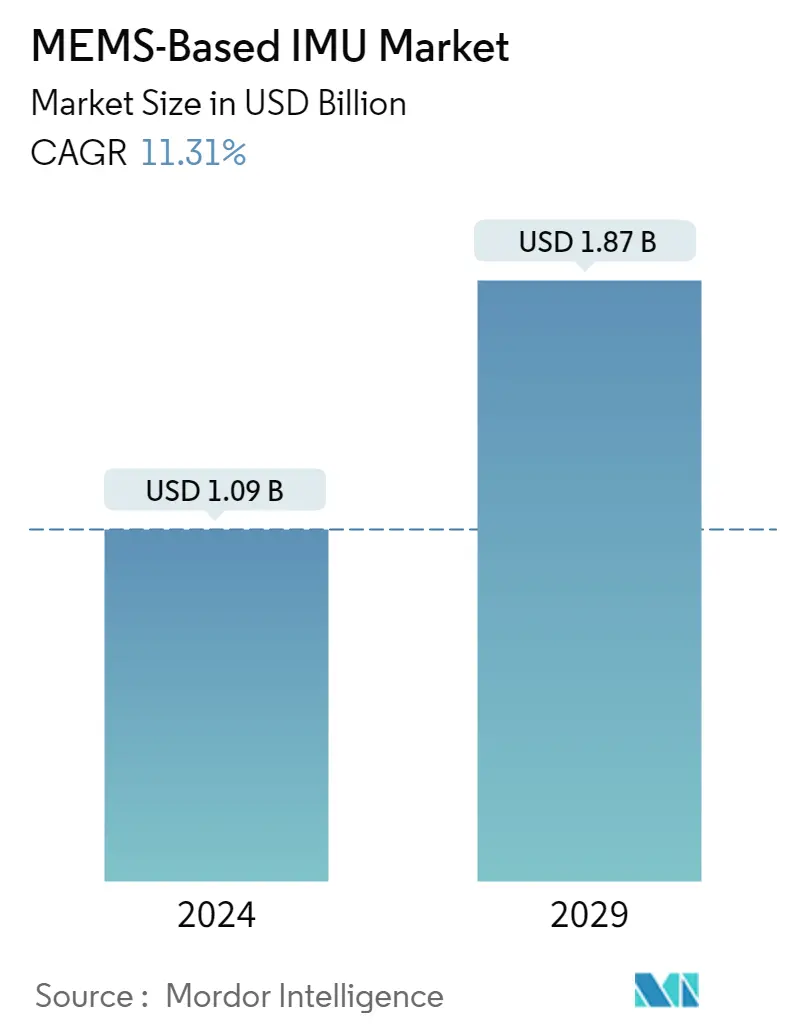Market Size of MEMS-Based IMU Industry

| Study Period | 2019 - 2029 |
| Market Size (2024) | USD 1.09 Billion |
| Market Size (2029) | USD 1.87 Billion |
| CAGR (2024 - 2029) | 11.31 % |
| Fastest Growing Market | Asia Pacific |
| Largest Market | North America |
Major Players
*Disclaimer: Major Players sorted in no particular order |
Need a report that reflects how COVID-19 has impacted this market and its growth?
MEMS Inertial Measurement Unit (IMU) Market Analysis
The MEMS-Based IMU Market size is estimated at USD 1.09 billion in 2024, and is expected to reach USD 1.87 billion by 2029, growing at a CAGR of 11.31% during the forecast period (2024-2029).
The market's growth is primarily fueled by the increase in the number of applications, technological advancements, and the increasing demand in emerging countries globally. The MEMS technology played a significant role in expanding the application base for inertial measurement systems by scaling down these devices' size and power consumption without compromising on their performance metrics, thereby driving the market's growth.
- The market studied is growing, as MEMS inertial sensors used in the unit offer highly robust, reliable, fast, and temperature-stable characteristics. They can detect even the most minor changes in position and acceleration. Furthermore, the growing development of IoT devices is driving the market's growth.
- The internal components of MEMS IMU need to be protected from harsh environments, such as heat, moisture, and corrosive chemicals. However, the high sensitivity to fabrication and environmental variations makes the packaging of IMU sensors, such as micromachined gyroscopes, a challenging task and increases the packaging cost, thereby hampering the market's growth. The market is facing heavy headwinds due to the outbreak of COVID-19 worldwide. Lockdowns enforced by the spread of COVID-19 worldwide affected the manufacturing of devices, dragged consumer demand across end-user industries, and influenced the prices. However, with the resurgence, the market demand will likely rise to the trend line.
- As global defense agencies become more dependent on precision weapons, the signal chain's performance, quality, and design are even more mission-critical. MEMS gyroscope strengthens the industry with three essential aspects of signal chain design.
- For instance, in December 2021, Honeywell announced the development of the next generation of MEMS-based inertial sensor technology with financing from the US Defense Advanced Research Projects Agency (DARPA), which will be used in both commercial and defense navigation applications. Honeywell lab studies recently revealed that the new sensors are more than an order of magnitude more precise than Honeywell's HG1930 inertial measurement unit (IMU), a tactical-grade device with more than 150,000 units in operation.
- Furthermore, the beginning of the COVID-19 pandemic has severely hit the market for MEMS-based IMU owing to the shutdown of several manufacturing industries. However, automakers globally have faced increased pressure to shut down their factories due to the COVID-19 pandemic. After the federal, state, and local governments started recommending people stay in their homes as much as possible. This has caused supply chain disruptions across various industries. For instance, Ford and General Motors suspended production at their respective manufacturing facilities in North America amid the coronavirus outbreak. Honda North America and BMW also closed their plants throughout the U.S. and Europe owing to an expected decline in car demand related to the global coronavirus outbreak.
